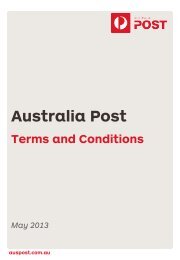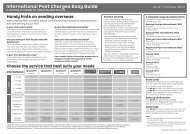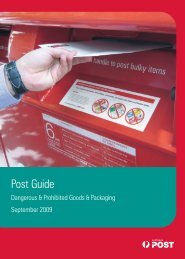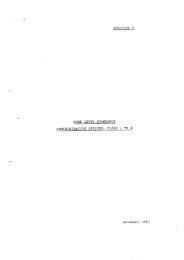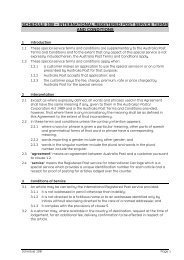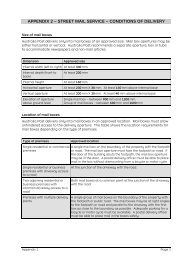2009-10 Annual Report - Australia Post
2009-10 Annual Report - Australia Post
2009-10 Annual Report - Australia Post
You also want an ePaper? Increase the reach of your titles
YUMPU automatically turns print PDFs into web optimized ePapers that Google loves.
(bb) interest-bearing liabilities<br />
all borrowings are initially recognised at the fair value of the<br />
consideration received less directly attributable transaction costs.<br />
after initial recognition, interest-bearing borrowings are subsequently<br />
measured at amortised cost using the effective interest method.<br />
Fees paid on the establishment of loan facilities that are yield<br />
related are included as part of the carrying amount of borrowings.<br />
Borrowings are classified as current liabilities unless the group has<br />
an unconditional right to defer settlement of the liability for at least<br />
12 months after the balance sheet date.<br />
(cc) Finance costs<br />
Finance costs directly attributable to the acquisition, construction or<br />
production of a qualifying asset (that is, an asset that necessarily takes<br />
a substantial period of time to get ready for its intended use or sale) are<br />
capitalised as part of the cost of that asset. the group does not<br />
currently hold qualifying assets.<br />
all other borrowing costs are expensed in the period in which they<br />
occur. Finance costs consist of interest and other costs that an entity<br />
incurs in connection with the borrowings of funds.<br />
(dd) Provisions (excluding employee benefits)<br />
provisions are recognised when the group has a present obligation<br />
(legal or constructive) as a result of a past event, it is probable that an<br />
outflow of resources embodying economic benefits will be required to<br />
settle the obligation and a reliable estimate can be made of the amount<br />
of the obligation.<br />
When the group expects some or all of a provision to be reimbursed<br />
– for example, under an insurance contract – the reimbursement is<br />
recognised as a separate asset, but only when the reimbursement<br />
is virtually certain. the expense relating to any provision is presented<br />
in the statement of comprehensive income net of any reimbursement.<br />
provisions are measured at the present value of management’s best<br />
estimate of the expenditure required to settle the present obligation<br />
at the reporting date. the discount rate used to determine the present<br />
value reflects current market assessments of the time value of money<br />
and the risks specific to the liability. When discounting is used, the<br />
increase in the provision due to the passage of time is recognised<br />
as a financing cost.<br />
(ee) employee leave benefits<br />
(i) wages, salaries, annual leave and sick leave<br />
liabilities for wages and salaries (including non-monetary benefits),<br />
expected to be settled within 12 months of the reporting date are<br />
recognised in other payables in respect of employees’ services up<br />
to the reporting date.<br />
liabilities for annual leave where the corporation does not have<br />
an unconditional right to defer settlement of the liability for at least<br />
12 months after the reporting date are recognised in current provisions<br />
at the amounts expected to be paid when the liabilities are settled.<br />
no liability is recognised for sick leave as benefits lapse with termination<br />
of employment and experience indicates that the pattern of sick leave<br />
taken is less than the entitlement accumulating.<br />
(ii) long service leave<br />
the liability for long service leave is recognised and measured as the<br />
present value of expected future payments to be made in respect of<br />
services provided by employees up to the reporting date using the<br />
projected unit credit method.<br />
consideration is given to expected future wage and salary levels,<br />
experience of employee departures and periods of service. expected<br />
future payments are discounted using market yields at the reporting date<br />
on national government bonds with terms to maturity and currencies<br />
that match, as closely as possible, the estimated future cash outflows.<br />
(iii) workers’ compensation<br />
the corporation is a licence holder under the Safety, Rehabilitation and<br />
Compensation Act 1988 (src act). the corporation self-insures its<br />
liability for workers’ compensation. claims are recognised in the financial<br />
statements and measured by the discounted value of an annuity. the<br />
adequacy of the provision is established by reference to the work of an<br />
actuary as at balance date, with the estimate of present value taking<br />
into account pay increases, attrition rates, interest rates and the time<br />
over which settlement is made.<br />
in accordance with its src act licensing conditions, the corporation has<br />
a bank guarantee to cover its outstanding actuarial established claims<br />
liability (see schedule of contingencies). the corporation also complies<br />
with a requirement to maintain reinsurance to limit its workers’<br />
compensation liabilities.<br />
the corporation has recognised a liability for workers’ compensation of<br />
$<strong>10</strong>6.7 million at balance date (refer note 20) of which $8.7 million<br />
relates to claims made in the <strong>2009</strong>–<strong>10</strong> financial year (2008–09:<br />
$7.8 million).<br />
(iv) separation and redundancy<br />
a liability is recognised for separation and redundancy benefit<br />
payments for ongoing major restructuring only where the corporation<br />
is demonstrably committed to the restructuring and the cost can be<br />
reliably measured (refer note 20). Generally such assessments do not<br />
exceed the certainty of initiatives planned for the following year.<br />
(ff) Pensions and other post-employment benefits<br />
the defined benefit plan requires contributions to be made to a<br />
separately administered fund. the cost of providing benefits under<br />
the defined benefit plan is determined using the projected unit credit<br />
actuarial valuation method. actuarial gains and losses are recognised<br />
in retained earnings.<br />
past service costs are recognised immediately to the extent that<br />
the benefits are already vested, and otherwise are amortised on<br />
a straight-line basis over the average period until the benefits<br />
become vested.<br />
the defined benefit asset or liability recognised in the balance sheet<br />
represents the present value of the defined benefit obligation, adjusted<br />
for unrecognised past service cost, net of the fair value of the plan<br />
assets. any asset resulting from this calculation is limited to past<br />
service costs plus the present value of available refunds and reductions<br />
in future contributions to the plan.<br />
AustrAliA <strong>Post</strong> AnnuAl rePort <strong>2009</strong>–<strong>10</strong> | Financial and statutory reports 57




